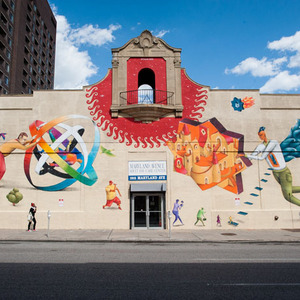"Important as good schools are, they prove totally undependable at rescuing bad neighborhoods and at creating good neighborhoods. Nor does a good school building guarantee a good education. Schools, like parks, are apt to be volatile creatures of their neighborhoods (as well as being creatures of larger policy). In bad neighborhoods, schools are brought to ruination, physically and socially; while successful neighborhoods improve their schools by fighting for them" (Jacobs 113).
 |
| http://baltimoredesignschool.com/#nav-option-1 |
This passage vividly reminded me of the Baltimore Design School. The community around this school is very supportive of the mission of the school and how it affects the respect and appreciation for the arts in young people. The fact that the community is rallying around the continuous development of the school supports Ms. Jacobs' writing in that neighborhoods become more successful when they fight for their schools.
"There are, of course, two ways of trying to see such a street. If a person gives the long view precedence, with its connotations of repetition and infinity, then the close-up scene and the intensity it conveys seem superfluous and offensive... If the foreground view, on the other hand, takes precedence, then the endless repetition and the continuation into lost, indefinite distances becomes the superfluous, offensive and senseless element... Looking at the street in this way, the viewer makes sense, and at least a minimum amount of order, from the intimate view, but only at the price of considering the distance as a deplorable mishmash, better dismissed from mind if possible" (Jacobs 379).
"Landmarks, as their name says, are prime orientation clues. But good landmarks in cities also perform two other services in clarifying the order of cities. First, they emphasize (and also dignify) the diversity of cities; they do this by calling attention the fact that they are different from their neighbors, and important because they are different... Second, in certain instances landmarks can make important to our eyes city areas which are important in functional fact but need to have that fact visually acknowledged and dignified" (Jacobs 384).
 |
| Circa 1948 |
This spoke to me because Baltimore has a lot of landmarks. A LOT. If you google "list of Baltimore City landmarks" the first entry is a downloadable list of no less than 162 landmarks. But I was drawn to the fact that even though I do not go to Baltimore very often, there are places that I consider to be landmarks of the city, and they are landmarks to me because I can't find them in other places and they draw attention to the areas of the city where they are located. Some of the landmarks I think of (and not all of these are in the SNAED) are Fort McHenry, Penn Station, the Senator Theatre (which is incredible if you have ever gone to see a movie premier - old-timey theater that's currently being renovated), the Inner Harbor (specifically the Aquarium)... The list goes on!
(all pictures of Senator Theatre from: http://jayberg.blogspot.com/
2010_07_01_archive.html)
"Centers of activity, where the paths of many people come together in concentrated fashion, are important places economically and socially in cities. Sometimes they are important in the life of a city as a whole, sometimes to a particular district or neighborhood. Yet such centers may not have the visual distinction or importance merited by the functional truth" (Jacobs 386-387).
  |
| Circa 1968 (before fire) Circa 2013 Both images from: http://citypaper.com/news/can-station-north-save-the-city-1.1514525 |
When I read this passage, I immediately thought of the North Avenue Market. The Market opened originally in 1928 with 12 retail stores and a bowling alley, and then was destroyed in a fire in 1968 only to be partially rebuilt into a supermarket in 1974. Today however, and in recent years, renovation projects have been started to rebuild the Market (Hoffman "North Avenue Market"). New restaurants, shops, offices, and concentration on art has begun to emerge in the Market to draw more people socially and professionally into SNAED. The reinvestment project still draws attention to the timelessness of the center while building on it to make it modern as well, so it serves many purposes. It is an economic source of the city but is also a social center.
"Eye-catchers, as already mentioned in the case of visual street interruptions, have an importance in city appearance out of all proportion to the physical space they occupy. Some eye-catchers are eye-catchers just by virtue of what they are, rather than because of precisely where they are... Other eye-catchers, however, are eye-catchers because of precisely where they are, and those are necessary to consider as a deliberate part of city design" (Jacobs 388-389).
 |
| http://www.zigersnead.com/current/events/details/1456/ |
This section of Jacobs' writing caused me to think about the overall emphasis on art in the SNAED. Even the murals painted on random buildings (some orchestrated by city officials and others just random "graffiti") are eye-catchers that give life to Baltimore. They are important because of their location and their meaning. The image pictured is an example of the Open Walls Baltimore art project that transformed the walls of different buildings in the SNAED. This particular mural is on North Avenue between Charles Street and Maryland Avenue.
Cities are beautiful things if one takes the time to look at everything that makes up a city. A city is not just buildings. Take a trip to Baltimore, or any city for that matter, and look beyond the walls and streets around you; you'll see!
My Sources
Hoffman, Elise. Baltimore Heritage. “North Avenue Market.” Explore Baltimore Heritage. n.p.,n.d. Web. 31 Jan. 2014. <http://explore.baltimoreheritage.org/items/show/57>.
Jacobs, Jane. The Death and Life of Great American Cities. New York: Random House, 1961. Print.










